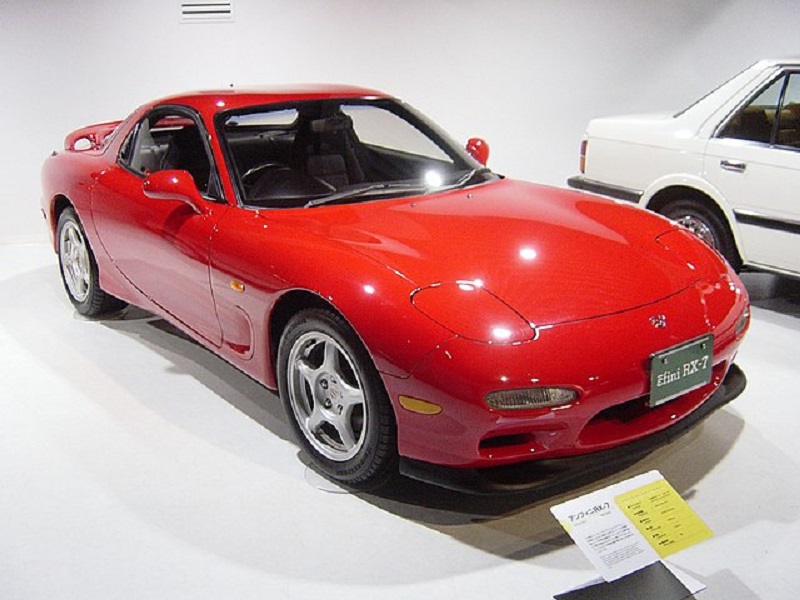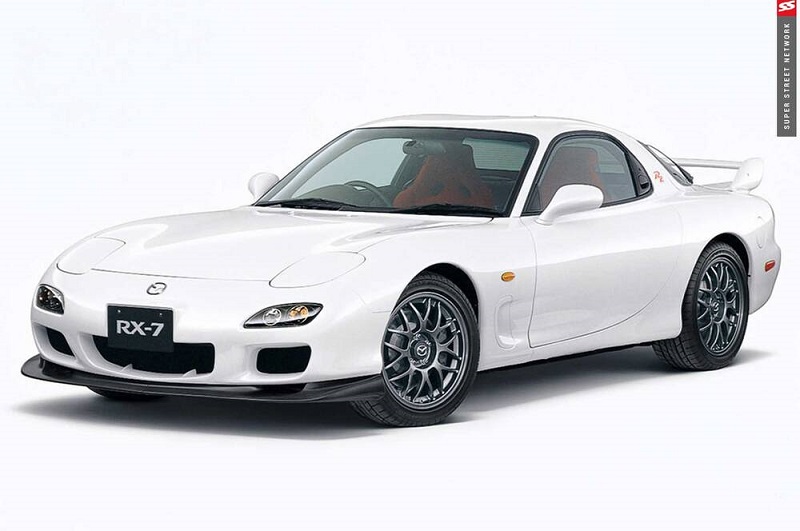From 1978 to 2002, the Japanese carmaker Mazda built the renowned sports automobile known as the Mazda RX7. Especially among auto aficionados and in motorsports, the RX7 swiftly rose to fame thanks to its unique rotary engine and elegant design. We’ll examine the Mazda RX7 in-depth in this post, covering its background, salient characteristics, technical details, and Indian pricing.

Read more: 1969 Ford Mustang: A Timeless Classic
1. The History of Mazda RX7
The Mazda RX-3 was replaced by the Mazda RX-7, which made its debut in 1978. The Wankel rotary engine, which distinguished the RX7 from its rivals despite its small size, was the focal point of the car’s design. The RX7 was produced for 24 years, going through three different versions, each of which added to the previous one’s performance, appearance, and technological capabilities.
1.1. First Generation (1978-1985)
First introduced as the SA/FB, the RX7 was powered by a rotary engine, initially the 12A and then the 13B. It was popular with driving purists since it was a lightweight vehicle with almost ideal weight distribution. The automobile had an eye-catching, straightforward yet sporty look, and its on-track exploits further cemented its reputation.
1.2. Second Generation (1986-1992)
The FC, the second-generation RX7, had cutting-edge technologies and sleeker appearance. It had a 13B rotary engine that was turbocharged, which improved performance and produced more horsepower. This version was a well-rounded sports car that appealed to both enthusiasts and everyday drivers. It also included features like independent rear suspension and a more opulent interior.
1.3. Third Generation (1992-2002)
Undoubtedly the most well-known and sought-after RX7 model is the third generation model, also referred to as the FD. The 13B sequential twin-turbocharged engine and svelte, aerodynamic design of the FD RX7 combined to provide outstanding performance. With its lightweight chassis, accurate handling, and powerful turbocharged engine, it was a serious contender on the racetrack. Because of its enormous tweaking potential, enthusiasts and vehicle tuners especially like this model of RX7.
2. Key Features of the Mazda RX7
The Mazda RX7 is known for several distinctive features, many of which contributed to its legendary status. These include:
- Rotary Engine: The heart of the RX7 is its rotary engine, which offers a higher power-to-weight ratio compared to traditional piston engines. This allowed Mazda to design a compact yet powerful sports car.
- Lightweight Design: Throughout its production, the RX7 maintained a focus on being lightweight, with a balanced chassis and an emphasis on agility.
- Perfect Weight Distribution: The RX7 is celebrated for its near 50/50 weight distribution, which, combined with its rear-wheel-drive layout, provides exceptional handling.
- Turbocharging: Particularly in the second and third generations, the introduction of turbocharging significantly enhanced performance, giving the RX7 an edge over many of its competitors.
3. Technical Specifications of the Mazda RX7
To better understand the performance and characteristics of the Mazda RX7, let’s break down the key specifications across its three generations:
| Specification | First Generation (SA/FB) | Second Generation (FC) | Third Generation (FD) |
|---|---|---|---|
| Engine | 12A, 13B Rotary | 13B Rotary (NA & Turbo) | 13B-REW Twin-Turbo Rotary |
| Horsepower | 100-135 HP | 146-200 HP | 255-280 HP |
| Transmission | 4-speed Automatic / 5-speed Manual | 5-speed Manual / 4-speed Auto | 5-speed Manual |
| 0-100 km/h (0-62 mph) | ~8.5 seconds | ~7.0 seconds | ~5.0 seconds |
| Top Speed | 190 km/h | 240 km/h | 250 km/h |
| Weight | ~1,100 kg | ~1,250 kg | ~1,280 kg |
| Fuel Economy | 9-12 km/l | 8-10 km/l | 6-9 km/l |
4. Performance and Driving Experience
There is no experience like driving a Mazda RX7. The car provides power in a smooth, linear manner because of the high revving characteristics of the rotary engine. The car feels snappy and nimble because of its lightweight construction, especially while cornering. Whether on a racetrack or a twisting road, its precision handling is made possible by its excellent balance and rear-wheel drive layout.
4.1. Tuning Potential
The RX7’s adaptability is one of the factors contributing to its continued popularity. The rotary engine may be tweaked to provide a good amount of power; many enthusiasts have successfully modified the 13B engine to produce more than 500 horsepower. There is a robust aftermarket community for the FD in particular, with parts to enhance handling, performance, and looks easily accessible.
5. Mazda RX7’s Popularity in Pop Culture
The RX7 became well-known throughout the world for its performance as well as for being a part of popular culture. The vehicle gained notoriety for its appearances in street racing films like The Fast and the Furious trilogy and video games like Gran Turismo and Need for Speed.

6. The Price of Mazda RX7 in India
Obtaining a Mazda RX7 is difficult because it was never formally offered in India. Nonetheless, it is now feasible to import an RX7 into the nation because of the vehicle’s widespread appeal and the rise of import retailers. A Mazda RX7 import into India is dependent on a number of factors:
- Import Duty: The cost of importing a car into India can be high due to heavy import duties, which can range from 100% to 125% of the car’s value.
- Price Range: Depending on the condition and the generation, an imported RX7 can cost anywhere between INR 25 lakh to INR 40 lakh or even more, considering the rarity and the demand for well-maintained models.
Here’s a breakdown of the approximate costs:
| Generation | Price in India (Estimate) |
|---|---|
| First Generation (SA/FB) | INR 25-30 lakh |
| Second Generation (FC) | INR 30-35 lakh |
| Third Generation (FD) | INR 35-40 lakh |
These prices can vary based on the car’s condition, modifications, and the cost of shipping and registration in India.
7. Challenges of Owning an RX7 in India
While owning an RX7 in India is a dream for many car enthusiasts, it comes with its own set of challenges:
- Maintenance: The rotary engine, while unique, requires special care. Finding mechanics familiar with the RX7’s rotary engine in India can be difficult.
- Fuel Efficiency: The RX7, especially the turbocharged models, is not known for fuel efficiency. In India, where fuel prices are relatively high, this can be a concern for daily driving.
- Parts Availability: Due to its rarity, sourcing replacement parts for the RX7 in India can be costly and time-consuming. Importing parts may be the only option in some cases.
8. Conclusion: A Dream Car for Enthusiasts
The Mazda RX7 is a vehicle that has captured the imagination of auto fans all around the world. It’s a really special sports car because of its lightweight construction, distinctive rotary engine, and driving dynamics. The potential of importing an RX7 gives hope to those who aspire to own this Japanese legend, even if it was never offered in India. The excitement of driving a Mazda RX7 may outweigh the high expenses and genuine maintenance and parts availability issues, but for many people, the car is still worth it.
Read more: Toyota Harrier: A Comprehensive Overview
FAQ Section
1. Why is the Mazda RX7 so popular?
The RX7 is popular because of its unique rotary engine, lightweight chassis, excellent handling, and its strong presence in motorsports and pop culture.
2. Is the RX7 legal in India?
Yes, the RX7 can be imported to India, but it was never officially sold in the country. The process involves significant costs due to import duties and regulations.
3. How much does it cost to import a Mazda RX7 to India?
The cost of importing an RX7 to India can range from INR 25 lakh to INR 40 lakh, depending on the car’s condition and generation.
4. What is the top speed of a Mazda RX7?
The top speed of the third-generation RX7 (FD) is approximately 250 km/h.
5. Is it difficult to maintain a Mazda RX7 in India?
Yes, maintaining an RX7 in India can be challenging due to the rotary engine’s complexity and the difficulty in finding mechanics familiar with it.
6. Why is the rotary engine in the RX7 unique?
The rotary engine is unique because it uses a different mechanism than traditional piston engines, allowing it to be smaller and lighter while producing significant power.


